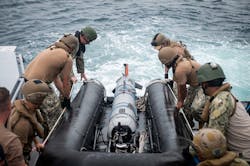Navy enhancing sensors, navigation, and autonomy capabilities for growing fleet of unmanned submarines
WASHINGTON – Huntington Ingalls Industries (HII) is widely known for its work on large warships and submarines. But the firm has also been designing and producing underwater drones to the Navy for many years now. It performed the first ever submarine-launched unmanned undersea vehicle in 2015. The REMUS drone was a milestone in undersea warfare history. Kris Osborn at The National Interest reports. Continue reading original article
The Military & Aerospace Electronics take:
8 Feb. 2022 -- The Navy has launched several unmanned underwater vehicles (UUVs) from submarines since then, including some from submarine missile tubes. The REMUS UUV class, which has been in existence for twenty years, includes the REMUS 100, REMUS 300, REMUS 600, and large REMUS 6000.
REMUS can use its sensors to explore hazardous areas autonomously, collecting valuable data for missions like mine countermeasures, area search, marine research, hydrographic survey, and reconnaissance.
The Navy is pursuing a wide range of unmanned systems including small, medium, large, and extra-large undersea UUVs, unmanned surface vessels, and unmanned aircraft. Most of all, the Navy is working to network all of them together.
Related: Unmanned submarines seen as key to dominating the world’s oceans
John Keller, chief editor
Military & Aerospace Electronics
